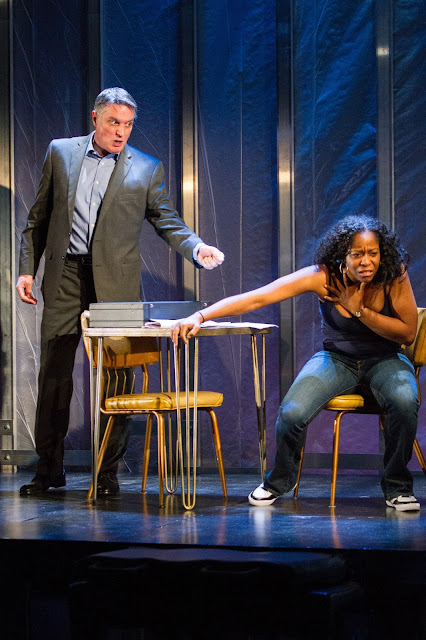"Caution: Roadwork Ahead"
 As its title suggests, Bruce Graham’s White Guy on the Bus is a play about race, as familiar but nonetheless pertinent a topic as any in today’s fractured American society. The play, which originated at Chicago’s Northlight Theatre and was subsequently performed elsewhere, comes to New York in its Delaware Theatre Company production, directed by Bud Martin.
As its title suggests, Bruce Graham’s White Guy on the Bus is a play about race, as familiar but nonetheless pertinent a topic as any in today’s fractured American society. The play, which originated at Chicago’s Northlight Theatre and was subsequently performed elsewhere, comes to New York in its Delaware Theatre Company production, directed by Bud Martin.It begins intriguingly with several button-pushing scenes that suggest we’re in for an evening of frank, perhaps uncomfortable, but definitely necessary discussion. The four participants are privileged white folks from Philadelphia’s Main Line: middle-aged Ray (Robert Cuccioli); his wife, Roz (Susan McVey); a younger man, Christopher (Jonathan Silver), the kid who grew up next door and whom Ray and Roz have treated like a son since he was four; and Christopher’s pretty fiancée, Molly (Jessica Bedford).
 |
| Susan McVey, Robert Cuccioli. Photo: Monique Carboni. |
Ray is the wealthy “numbers man” who runs a successful finance company but, as somebody who’s always cautioning others to look at “the big picture,” is ready to throw it all away and run off to live like Paul Gauguin. Roz, his tastefully appareled spouse (costumes are by Wade Laboissonniere), several times nominated for a national Teacher of the Year award, teaches poor black kids in an inner city school where she counts how many times she’s called “white bitch.” While it’s certainly possible a white woman married to a millionaire would devote herself to such a career, with all its obstacles, McVey's elegant presence doesn't convey that she's that person.
 |
| Robert Cuccioli, Danielle Leneé. Photo: Monique Carboni. |
Christopher, a sociology college teacher aiming for tenure, hopes for approval of his dissertation topic on “Male African-American Images in Television Marketing.” And Molly’s a guidance counselor for a mostly white girls’ private school in Bryn Mawr. The setup is formulaic but still promising.
Gradually the play introduces an impoverished black character, Shatique (Danielle Leneé), a fortyish woman from a North Philadelphia ghetto; the mother of a nine-year-old boy, she’s studying to be a nurse so she can escape the junkies and crime in her neighborhood. Over a number of Saturdays, Ray, in the play’s time-bending structure, befriends Shatique by sitting next to her on a bus taking her to visit her brother, Sharif, incarcerated for a multiple murder.
 |
Robert Cuccioli, Danielle Leneé. Photo: Monique Carboni.
|
Ray’s conversations with his family, at one side of the stage, and his relationship with Shatique at the other, eventually converge in a disturbing shift when we learn what Ray is after with Shatique, a shift that throws the play off balance into a schematic ditch of unconvincing crime melodrama.
 |
| Susan McVey, Robert Cuccioli. |
When Ray, Roz, Christopher, and Molly get together, the conversation, driven by Roz’s preoccupations, inevitably brings her perceptions of race into conflict with those of Molly, while Christopher’s choice of a subject dealing with black men takes us further into the maelstrom of racial perceptions. There is much interesting exploration of the casual things that unconsciously betray racist attitudes in people who’d never admit, even to themselves, to having them. But it's hard to escape a feeling of overt didacticism.
 |
Robert Cuccioli, Danielle Leneé. Photo: Monique Carboni.
|
When a shocking incident (offstage) affects one of the four white characters and Ray makes a decision to use his money to rectify it, lots of verbal and physical fireworks erupt relevant to the play’s themes. The inciting incident, so to speak, isn’t implausible but the response it inspires in Ray is so far-fetched that, no matter how innately significant and dramatic are the moral questions to which it gives rise, it simply fails to rings true. Shatique’s dilemma, however, is more credible since she’s put in the position of being the executor of someone else’s wishes.
The resolution of the subplot concerning the reaction to Christopher’s dissertation proposal also opens questions. I won’t waste space on the details but will simply note that--despite the dramatist being a professor at Drexel University--there’s talk about matters surrounding Christopher’s tenure and PhD that doesn't always jibe with academic processes.
 |
| Robert Cuccioli. Photo: Monique Carboni. |
Little in the physical production itself serves the play’s interests well. One side of Paul Tate DePoo III’s set, which serves as a neutral space for the homes of Roz and Ray and Christopher and Molly, can’t make up its mind as to whether it’s an interior or exterior, The other side is for the bus rides and scenes featuring Shatique’s apartment, with plastic sheets covering steel beams, as if the contractor ran out of sheetrock.
 |
Danielle Leneé. Photo: Monique Carboni.
|
More seriously, most of the acting plays only with surfaces; all the performers have technical polish but, except for Leneé, who draws considerable power from her role, an air of artificiality hovers. The highly regarded Cuccioli, for example, captures Ray's cocky self-confidence but the role's requirements make it hard to accept him as anything more than a theatrical construct.
When White Guy on the Bus leaves the terminal it seems to be headed in the right direction as a racially charged drama; somewhere along the way, though, it makes a wrong turn and runs into plotting potholes.
When White Guy on the Bus leaves the terminal it seems to be headed in the right direction as a racially charged drama; somewhere along the way, though, it makes a wrong turn and runs into plotting potholes.
OTHER VIEWPOINTS:
59E59 Theaters/Theater A
59 E. 59th St., NYC
Through April 16


